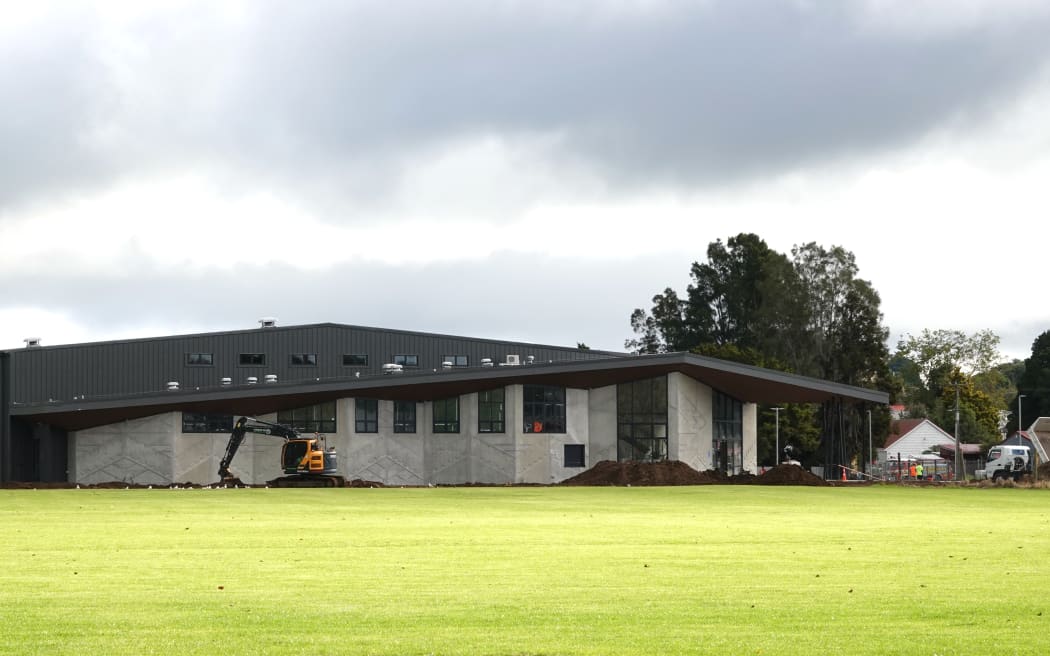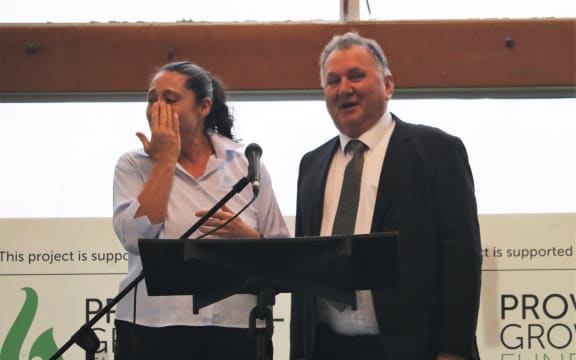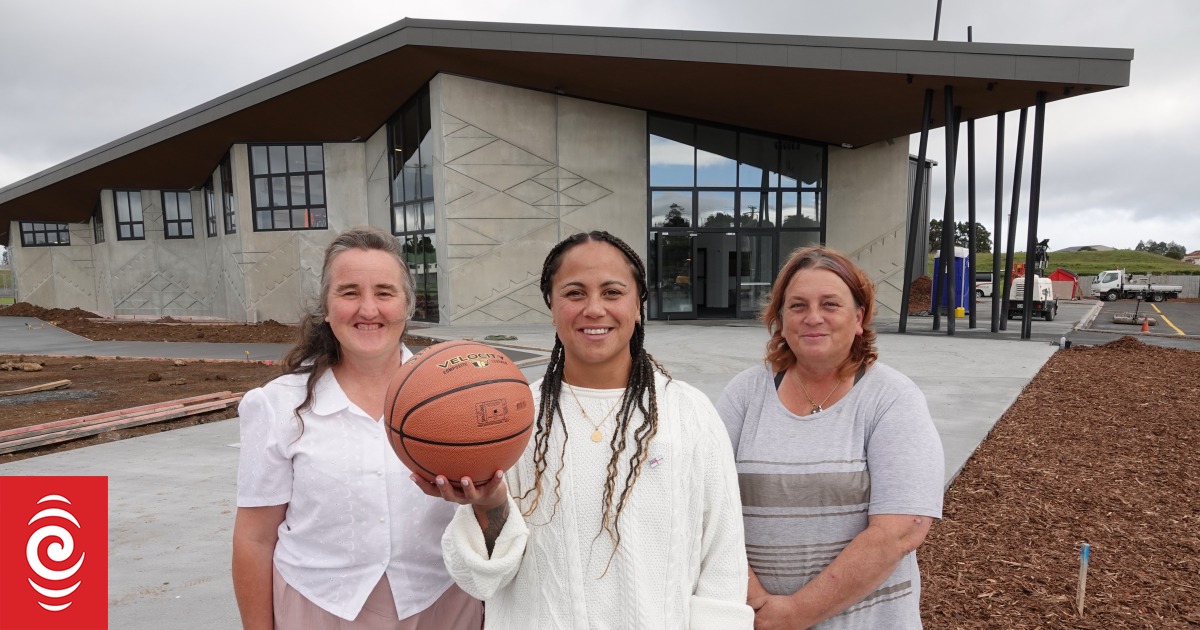
From left, Kaikohe and Districts Sportsville board secretary Debbie Raphael, sports coordinator Kohi Woodman and co-chair Suzee Ross outside the almost-completed indoor stadium.
Photo: RNZ
A decades-old dream of an indoor sports stadium in Kaikohe will finally become reality tomorrow.
Before dawn on Saturday, Ngāpuhi elders will bless and name the new sports facility, which has been built next to the town’s existing playing fields at Lindvart Park at a cost of $15 million.
Kaikohe has produced more than its share of world champions – think Black Ferns Cheryl Waaka and Portia Woodman, boxer Daniella Smith, even unicyclist Chris Huriwai – but mostly the town’s up-and-coming sports stars have to leave town to make it big.
That’s because, until now, the town didn’t facilities for training in all weather or taking sport to a higher level.
That’s despite census data showing Kaikohe has Northland’s youngest population.
Justin Blaikie, a past chairman of Kaikohe and Districts Sportsville, said the building was designed for more than 20 sporting codes.
It had two full-size courts for basketball, volleyball and netball – or one competition-sized basketball court – and would also cater to badminton, futsal and other indoor sports.
It had a sprung wooden floor – “the highest spec surface you can get for indoor sports” – plus a mezzanine level for spectators, changing and canteen facilities, passive temperature control to keep running costs down, and acoustic panels lining the interior walls so it could be used for large-scale community events such as cultural festivals.

The centre’s original concept design was prepared by rangatahi (youth) working with Kaikohe’s Ākau Design.
Photo: RNZ
The project’s outdoor elements included field lighting so football and league could practise after dark, parking, public toilets and a freedom camping area with wifi and security lighting.
Carvings alluding to local history would be unveiled on Saturday.
Blaikie said the centre would bring many benefits, such as increased opportunities for physical activity and access to sport in the winter months.
“That’s particularly important in this digital age when we’ve got young people spending a lot more time on screens and on their phones,” he said.
A number of schools in the area, in particular Kaikohe Christian School and Te Kura Kaupapa Māori o Kaikohe, did not have their own gyms so they would be core tenants.
Blaikie said Kaikohe residents had been working towards an indoor stadium for many years but the game-changer came in 2020, when then Economic Development Minister Shane Jones announced a $6.25 million grant from the government’s Covid-19 Response and Recovery Fund.

Former world champion Black Fern Cheryl Waaka wipes away a tear of joy in July 2020 as Regional Development Minister Shane Jones announces a $6.25m grant for Kaikohe’s indoor stadium.
Photo: Peter de Graaf
Even then, however, the sport centre’s path to completion was far from smooth, with construction only confirmed in 2023.
Blaikie said the biggest challenges were post-Covid cost escalations and reaching project milestones on time to avoid losing government funding.
“You’ve got this huge expectation from the community that wants all the bells and whistles, but in reality, we had to make a few alterations to the initial design. I still think we’ve still come away with a pretty amazing resource for the community.”
The main compromise involved a 300sqm gym that would have catered to gymnastics, dance and martial arts.
“We had to cut that particular part of the design, which was hugely disappointing – but our view was it was better to push on and secure the funding that we had.”
The centre had been designed so the gymnasium could be tacked on in future, Blaikie said.
“Just looking at the bookings we’ve got, and the interest from the community, we’d probably be justified to apply for additional funding to build that later on.”
Blaikie said the centre would do more than just improve health.
“It’s also given the community a shot in the arm, in terms of seeing that we can dream big and we can achieve these projects if we all work together collaboratively,” he said.
Current Kaikohe and Districts Sportsville co-chair Suzee Ross said the push for an indoor stadium began in earnest in 2009.
She had returned to the town after several years away, and found there were fewer opportunities for tamariki [children] than when she was growing up.
“I wanted a better future for our kids and for our town,” she said.
“Originally I just wanted a tin shed, where I could run some gymnastics and activities out of the rain. Back then, that would’ve cost around $700,000.”
Ross said the completed facility was state-of-the-art and “a true blessing for Kaikohe”.
“Every time I walk in here I cry. I wasn’t expecting it to be this amazing, to be honest. I think the kids are going to love it. We’re just really, really proud that we’ve managed to pull this all together.”
Stephen Jones, of lead contractor Canam, said the concept design was created by local rangatahi [youth] working with Ākau Design Studio.
A team of consultants worked to turn that vision into reality, he said.
Construction challenges included the site’s flood risk, when meant the whole building had to be raised by a metre, and having to meet tight deadlines when Covid lockdowns hampered the movement of machinery and material.
Jones said he used as many local businesses as possible, with about 95 percent of contractors from the Far North or Whangārei.
The external pre-cast concrete panels, for example, were made in Kerikeri.
The sprung floor was one of very few things that could not be sourced in Northland, Jones said.
Far North Mayor Moko Tepania said the new sports centre would be “absolutely fantastic” not just for Kaikohe but also the wider Mid North and Hokianga.
“The benefits go beyond purely physical health. I think about the te ao Māori notion of holistic well-being, Te Whare Tapa Whā, and the mental, social, physical and spiritual benefits that will come from having such a beautiful venue in our district.”
Tepania said that was why the council had contributed about $4.4 million to project, and was also putting money into sports hubs at Waipapa and Kaitāia.
The blessing will begin at 4.30am on Saturday with the doors opening to the public from 10am.



